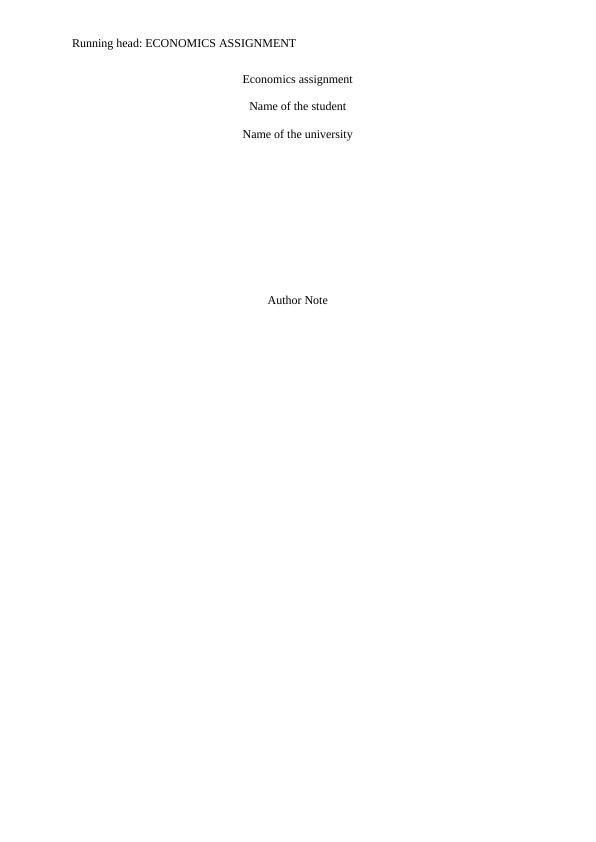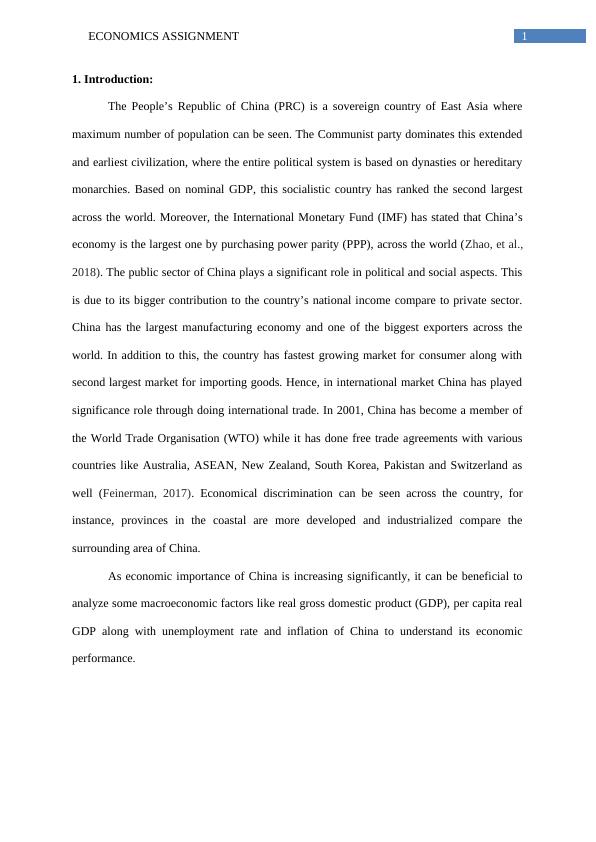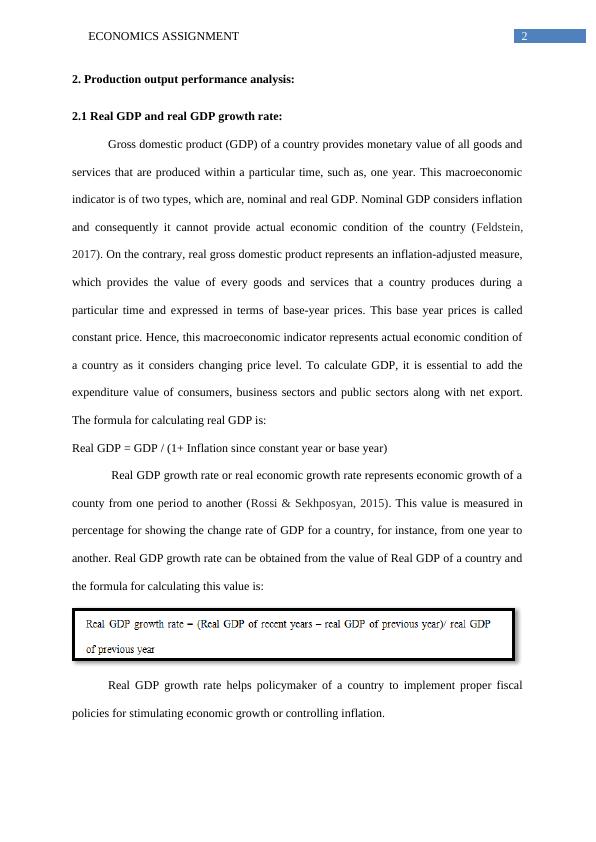Analysis of Macroeconomic Factors of China's Economic Performance
Added on 2023-06-09
12 Pages3112 Words76 Views
Running head: ECONOMICS ASSIGNMENT
Economics assignment
Name of the student
Name of the university
Author Note
Economics assignment
Name of the student
Name of the university
Author Note

1ECONOMICS ASSIGNMENT
1. Introduction:
The People’s Republic of China (PRC) is a sovereign country of East Asia where
maximum number of population can be seen. The Communist party dominates this extended
and earliest civilization, where the entire political system is based on dynasties or hereditary
monarchies. Based on nominal GDP, this socialistic country has ranked the second largest
across the world. Moreover, the International Monetary Fund (IMF) has stated that China’s
economy is the largest one by purchasing power parity (PPP), across the world (Zhao, et al.,
2018). The public sector of China plays a significant role in political and social aspects. This
is due to its bigger contribution to the country’s national income compare to private sector.
China has the largest manufacturing economy and one of the biggest exporters across the
world. In addition to this, the country has fastest growing market for consumer along with
second largest market for importing goods. Hence, in international market China has played
significance role through doing international trade. In 2001, China has become a member of
the World Trade Organisation (WTO) while it has done free trade agreements with various
countries like Australia, ASEAN, New Zealand, South Korea, Pakistan and Switzerland as
well (Feinerman, 2017). Economical discrimination can be seen across the country, for
instance, provinces in the coastal are more developed and industrialized compare the
surrounding area of China.
As economic importance of China is increasing significantly, it can be beneficial to
analyze some macroeconomic factors like real gross domestic product (GDP), per capita real
GDP along with unemployment rate and inflation of China to understand its economic
performance.
1. Introduction:
The People’s Republic of China (PRC) is a sovereign country of East Asia where
maximum number of population can be seen. The Communist party dominates this extended
and earliest civilization, where the entire political system is based on dynasties or hereditary
monarchies. Based on nominal GDP, this socialistic country has ranked the second largest
across the world. Moreover, the International Monetary Fund (IMF) has stated that China’s
economy is the largest one by purchasing power parity (PPP), across the world (Zhao, et al.,
2018). The public sector of China plays a significant role in political and social aspects. This
is due to its bigger contribution to the country’s national income compare to private sector.
China has the largest manufacturing economy and one of the biggest exporters across the
world. In addition to this, the country has fastest growing market for consumer along with
second largest market for importing goods. Hence, in international market China has played
significance role through doing international trade. In 2001, China has become a member of
the World Trade Organisation (WTO) while it has done free trade agreements with various
countries like Australia, ASEAN, New Zealand, South Korea, Pakistan and Switzerland as
well (Feinerman, 2017). Economical discrimination can be seen across the country, for
instance, provinces in the coastal are more developed and industrialized compare the
surrounding area of China.
As economic importance of China is increasing significantly, it can be beneficial to
analyze some macroeconomic factors like real gross domestic product (GDP), per capita real
GDP along with unemployment rate and inflation of China to understand its economic
performance.

2ECONOMICS ASSIGNMENT
2. Production output performance analysis:
2.1 Real GDP and real GDP growth rate:
Gross domestic product (GDP) of a country provides monetary value of all goods and
services that are produced within a particular time, such as, one year. This macroeconomic
indicator is of two types, which are, nominal and real GDP. Nominal GDP considers inflation
and consequently it cannot provide actual economic condition of the country (Feldstein,
2017). On the contrary, real gross domestic product represents an inflation-adjusted measure,
which provides the value of every goods and services that a country produces during a
particular time and expressed in terms of base-year prices. This base year prices is called
constant price. Hence, this macroeconomic indicator represents actual economic condition of
a country as it considers changing price level. To calculate GDP, it is essential to add the
expenditure value of consumers, business sectors and public sectors along with net export.
The formula for calculating real GDP is:
Real GDP = GDP / (1+ Inflation since constant year or base year)
Real GDP growth rate or real economic growth rate represents economic growth of a
county from one period to another (Rossi & Sekhposyan, 2015). This value is measured in
percentage for showing the change rate of GDP for a country, for instance, from one year to
another. Real GDP growth rate can be obtained from the value of Real GDP of a country and
the formula for calculating this value is:
Real GDP growth rate helps policymaker of a country to implement proper fiscal
policies for stimulating economic growth or controlling inflation.
2. Production output performance analysis:
2.1 Real GDP and real GDP growth rate:
Gross domestic product (GDP) of a country provides monetary value of all goods and
services that are produced within a particular time, such as, one year. This macroeconomic
indicator is of two types, which are, nominal and real GDP. Nominal GDP considers inflation
and consequently it cannot provide actual economic condition of the country (Feldstein,
2017). On the contrary, real gross domestic product represents an inflation-adjusted measure,
which provides the value of every goods and services that a country produces during a
particular time and expressed in terms of base-year prices. This base year prices is called
constant price. Hence, this macroeconomic indicator represents actual economic condition of
a country as it considers changing price level. To calculate GDP, it is essential to add the
expenditure value of consumers, business sectors and public sectors along with net export.
The formula for calculating real GDP is:
Real GDP = GDP / (1+ Inflation since constant year or base year)
Real GDP growth rate or real economic growth rate represents economic growth of a
county from one period to another (Rossi & Sekhposyan, 2015). This value is measured in
percentage for showing the change rate of GDP for a country, for instance, from one year to
another. Real GDP growth rate can be obtained from the value of Real GDP of a country and
the formula for calculating this value is:
Real GDP growth rate helps policymaker of a country to implement proper fiscal
policies for stimulating economic growth or controlling inflation.

3ECONOMICS ASSIGNMENT
2.2 Real GDP growth rate analysis on China:
2004 2006 2008 2010 2012 2014 2016
0
2
4
6
8
10
12
14
16
GDP growth (annual %)
GDP growth (annual %)
Figure 1: Real GDP growth rate of China
Source: (Data.worldbank.org, 2018)
Figure 1 has represented slow down of China’s real GDP growth rate since 2006. In
this context, two reasons can be discussed to analyse this negative economic outcome of this
country. Firstly, manufacturing sector has controlled economic condition of this county for
long years. However, due to large number of aged population and lower wages, China has
influenced young generations adversely to get a job in this sector (Data.worldbank.org,
2018). Secondly, the global financial crisis of 2008 has not influenced this country
significantly though after effect of this crisis has become one of main causes to reduce
economic growth of this country. The government has spent huge amount of money during
this phase for which huge amount of debt has been generated (Feenstra et al., 2013).
Moreover, the government of this country is has tried to shift it export and manufacturing
sectors towards a service one for which the value of net export has declined in China.
2.2 Real GDP growth rate analysis on China:
2004 2006 2008 2010 2012 2014 2016
0
2
4
6
8
10
12
14
16
GDP growth (annual %)
GDP growth (annual %)
Figure 1: Real GDP growth rate of China
Source: (Data.worldbank.org, 2018)
Figure 1 has represented slow down of China’s real GDP growth rate since 2006. In
this context, two reasons can be discussed to analyse this negative economic outcome of this
country. Firstly, manufacturing sector has controlled economic condition of this county for
long years. However, due to large number of aged population and lower wages, China has
influenced young generations adversely to get a job in this sector (Data.worldbank.org,
2018). Secondly, the global financial crisis of 2008 has not influenced this country
significantly though after effect of this crisis has become one of main causes to reduce
economic growth of this country. The government has spent huge amount of money during
this phase for which huge amount of debt has been generated (Feenstra et al., 2013).
Moreover, the government of this country is has tried to shift it export and manufacturing
sectors towards a service one for which the value of net export has declined in China.

End of preview
Want to access all the pages? Upload your documents or become a member.
Related Documents
Macroeconomic Analysis of Australia: Real GDP Growth, Inflation, Unemployment, Net Export and Real Exchange Ratelg...
|14
|3472
|388
Macroeconomic Performance of Australia from 1990 to 2016lg...
|13
|3611
|62
Economic Performance of Australia: Analysis of GDP, Unemployment Rate and Inflation Ratelg...
|13
|2832
|80
Analyzing UK Economy's Performance with Macroeconomic Indicatorslg...
|10
|2761
|371
Economic Performance Analysis of Singapore (2005-2014)lg...
|15
|3197
|181
Analysis of Australia’s Macroeconomic Factors: Production Output Performance, Unemployment, Inflation and Pricelg...
|14
|3213
|250
